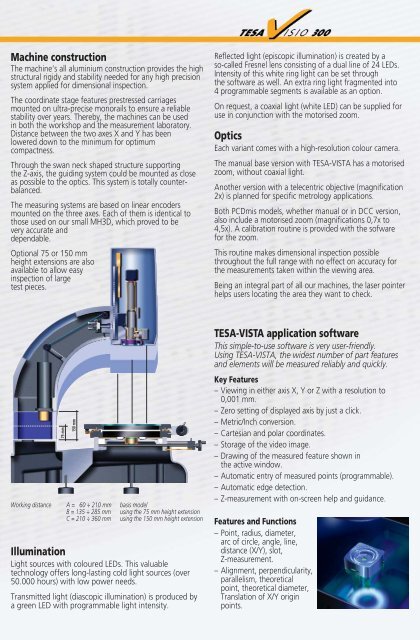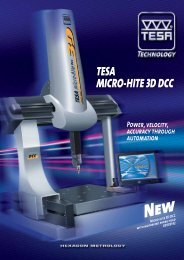Create successful ePaper yourself
Turn your PDF publications into a flip-book with our unique Google optimized e-Paper software.
Machine construction<br />
The machine’s all aluminium construction provides the high<br />
structural rigidy and stability needed for any high precision<br />
system applied for dimensional inspection.<br />
The coordinate stage features prestressed carriages<br />
mounted on ultra-precise monorails to ensure a reliable<br />
stability over years. Thereby, the machines can be used<br />
in both the workshop and the measurement laboratory.<br />
Distance between the two axes X and Y has been<br />
lowered down to the minimum for optimum<br />
compactness.<br />
Through the swan neck shaped structure supporting<br />
the Z-axis, the guiding system could be mounted as close<br />
as possible to the optics. This system is totally counterbalanced.<br />
The measuring systems are based on linear encoders<br />
mounted on the three axes. Each of them is identical to<br />
those used on our small MH3D, which proved to be<br />
very accurate and<br />
dependable.<br />
Optional 75 or 150 mm<br />
height extensions are also<br />
available to allow easy<br />
inspection of large<br />
test pieces.<br />
75 mm<br />
150 mm<br />
Working distance A = 60 ÷ 210 mm basis model<br />
B = 135 ÷ 285 mm using the 75 mm height extension<br />
C = 210 ÷ 360 mm using the 150 mm height extension<br />
Illumination<br />
Light sources with coloured LEDs. This valuable<br />
technology offers long-lasting cold light sources (over<br />
50.000 hours) with low power needs.<br />
Transmitted light (diascopic illumination) is produced by<br />
a green LED with programmable light intensity.<br />
Reflected light (episcopic illumination) is created by a<br />
so-called Fresnel lens consisting of a dual line of 24 LEDs.<br />
Intensity of this white ring light can be set through<br />
the software as well. An extra ring light fragmented into<br />
4 programmable segments is available as an option.<br />
On request, a coaxial light (white LED) can be supplied for<br />
use in conjunction with the motorised zoom.<br />
Optics<br />
Each variant comes with a high-resolution colour camera.<br />
The manual base version with <strong>TESA</strong>-VISTA has a motorised<br />
zoom, without coaxial light.<br />
Another version with a telecentric objective (magnification<br />
2x) is planned for specific metrology applications.<br />
Both PCDmis models, whether manual or in DCC version,<br />
also include a motorised zoom (magnifications 0,7x to<br />
4,5x). A calibration routine is provided with the sofware<br />
for the zoom.<br />
This routine makes dimensional inspection possible<br />
throughout the full range with no effect on accuracy for<br />
the measurements taken within the viewing area.<br />
Being an integral part of all our machines, the laser pointer<br />
helps users locating the area they want to check.<br />
<strong>TESA</strong>-VISTA application software<br />
This simple-to-use software is very user-friendly.<br />
Using <strong>TESA</strong>-VISTA, the widest number of part features<br />
and elements will be measured reliably and quickly.<br />
Key Features<br />
– Viewing in either axis X, Y or Z with a resolution to<br />
0,001 mm.<br />
– Zero setting of displayed axis by just a click.<br />
– Metric/Inch conversion.<br />
– Cartesian and polar coordinates.<br />
– Storage of the video image.<br />
– Drawing of the measured feature shown in<br />
the active window.<br />
– Automatic entry of measured points (programmable).<br />
– Automatic edge detection.<br />
– Z-measurement with on-screen help and guidance.<br />
Features and Functions<br />
– Point, radius, diameter,<br />
arc of circle, angle, line,<br />
distance (X/Y), slot,<br />
Z-measurement.<br />
– Alignment, perpendicularity,<br />
parallelism, theoretical<br />
point, theoretical diameter,<br />
Translation of X/Y origin<br />
points.



